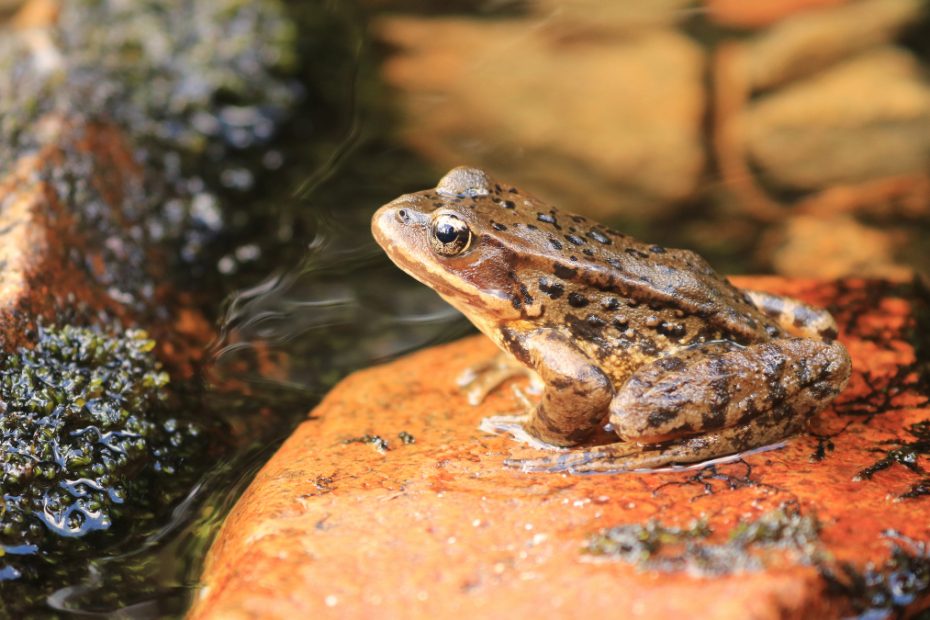Cascade Frogs, also known as Cascades Frog or Rana cascadae, are a species of small-sized frogs in the Pacific Northwest. These frogs have unique brown to green coloration, with a distinct light stripe and short, round snouts.
Studying and protecting these unique frog populations is of utmost importance, for these amphibians form a crucial ecosystem element. As predators of insects, these frogs help keep insect populations in check; as prey, they provide sustenance to other animals.
Moreover, these frogs are known to be indicator species; hence, their presence or absence can indicate the state of their habitat’s wellbeing. For instance, their existence suggests that the water is in good condition and capable of sustaining a wide array of aquatic life.
This guide covers Cascade Frogs habitat, behavior, diet, and reproductive strategies. Also, it explores threats to their survival and conservation efforts. In addition, we’ll discuss the importance of monitoring and managing their populations to ensure their long-term survival and the health of their ecosystem.
Taxonomy
While there may be color variation and pattern, there are no subspecies of the Cascade frog. Until 1939, it was considered a subspecies of the Oregon Spotted Frog (Rana pretiosa). However, further genetic studies split them into distinct species, with Rana Cascadae being the current scientific name of Cascade frogs.

Rana Cascadae belongs to the family Ranidae, the largest frog family in the world. It’s in the genus Rana, which comprises many other species of true frogs. Below is a breakdown of the Rana Cascadae taxonomy.
| Kingdom | Animalia |
| Phylum | Chordata |
| Class | Amphibia |
| Order | Anura |
| Family | Ranidae |
| Genus | Rana |
| Species | R.Cascadae |
| Scientific Name | Rana Cascadae |
| Common Name | Cascades Frog |
Cascade Frog Physical Characteristics

R.Cascadae is a fascinating species of amphibian that exhibits unique physical characteristics.
Size and Weight
R.Cascadae are small, medium-sized frogs. While weight data is not available, the length measurements for fully grown adult specimens range from 1.75 to 3 inches. Interestingly, females tend to be larger in size, measuring up to 3 inches and weighing up to 56g. Their male counterparts only grow up to 2.5 inches in length and weigh up to 28g.
Appearance
R.Cascadae have a slim waist and relatively long stretched-out hind legs with light webbing. Though smooth, the skin is covered in small bumps or warts.
Lateral eyes are oriented outward, with a distinct dark mask around them. Perhaps the most defining feature is the dorsolateral fold, a parallel ridge of the skin that runs on the top sides of the body.
Coloration and markings
The frog’s color and pattern may vary based on location and individual variation. The base color or back color is typically brown or olive green.
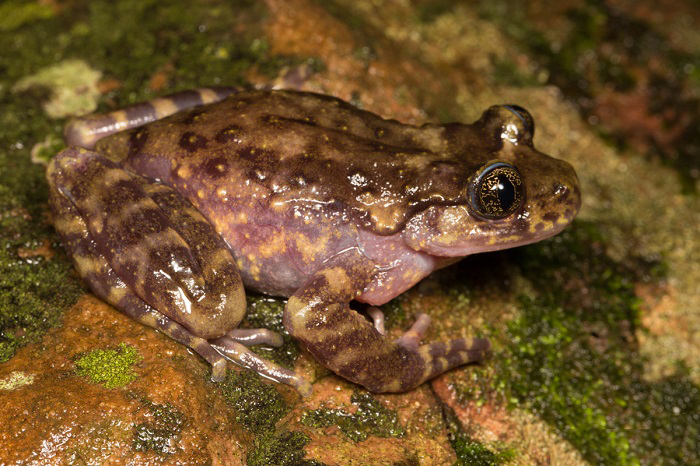
Though uncommon, you can also get individuals with copper or tan base color. Regardless, the back color has dark irregular blotches or spots. These can range from light brown/gray to dark black.
The throat, belly, and back of the legs have a lighter yellowish color. The frog’s sides are cream-colored, with dark blotches around the groin. A dark face mask, golden eyes, and a light upper jaw stripe that extends to the shoulder add to its unique appearance.
Vocalization
These frogs are recognizable for their repeated series of low-pitched, grating clucks. Often, the intensity can vary depending on the specific context in which the frog is calling. For instance, male frogs are more persistent in their calling during mating season.
Habitat and Behavior
Rana Cascadae is native to the mountainous region of Western North America, mainly the Cascade Range and the Olympic Mountains. Its habitat stretches across three states: Washington, California, and Oregon. Apparently, this frog has developed unique behavior, making it well-adapted to life on the mountains. Let’s explore its mountain ecosystems and behavior in detail.
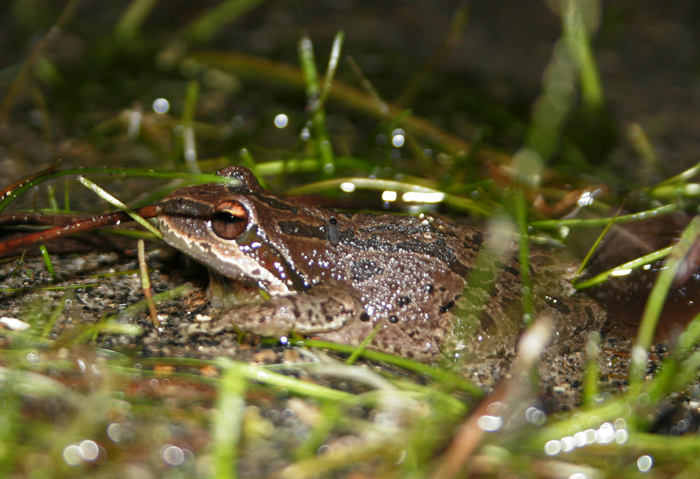
Cascade Frog Habitats
- Geographical distribution: Contrary to their name, these frogs are not only native to the Cascade Mountains of Washington and Oregon. You can also find them in Washington’s Olympic Peninsula. Other frog populations are in Northwest and North Central California at Klamath-Siskiyou region and Lassen Peak, respectively.
- Preferred environment: Frog ecology includes open coniferous forests, grassland, and inland water bodies. More specifically, they prefer wet mountain meadows, bogs, ponds, slow-moving streams, and wadeable lakes.
They’re more attracted to clean, permanent water sources and open areas with vegetation and rocks. Rock crevices and vegetation provide perfect spots to soak up the sun, forage for food, and conceal themselves from potential predators.
- Elevation range: R.Cascadae prefers high elevation areas, ranging from 400 m (1312 feet) to 2500 m (8200 feet). The elevation range tends to vary with habitat location.
Generally, you’ll find them at lower elevations in the Washington region, as low as 755 feet. In areas like Oregon, however, you’ll find them at a higher elevation, often starting from 2500 feet.
Cascade Frog Behavior

Rana cascadae is known for its unique behavior that allows it to thrive in its habitat.
- Activity Patterns: Cascade frog activity peaks during the day. Though primarily diurnal, they may also show nocturnal activities, especially in warm summer.
According to the United States Fish and Wildlife Service, these frogs are more active during the spring and summer months of May to October. However, there’s no activity during winter. Instead, the frogs would hibernate by burrowing into muddy bottoms of ponds and lakes.
- Locomotion: These frogs move around by leaping, hopping, and jumping. Long, powerful hind legs allow them to jump high and leap significant distances. Also, webbed feet make these frogs excellent swimmers. However, they’re not known for climbing as they lack adhesive toe pads for gripping.
- Social Structure: Unlike most frogs that live in colonies, Rana cascadae are solitary, preferring to live alone. However, these frogs exhibit some social behavior during the breeding season, when they gather in groups to mate.
- Communication: These frogs communicate by vocalization or chemical signals. Their distinctive call is a series of short, low-pitched grating and clucking sounds.
Males use this call during the mating season since females are attracted to males with the loudest, longest call. Also, frogs use pheromones to communicate. Plus, they can communicate through touch and body movement.
- Predators and Defense Mechanisms: Garter snakes, coyotes, raccoons, and other small animals prey on adult Cascade frogs. Other predators include birds, mostly owls, sharp-shinned hawks (sharpie), and the American robins.
The frogs employ different self-defence mechanisms such as:
- Hopping and swimming away once it detects a predator
- Playing dead to fool predators
- Using camouflage to hide their environment
- Secretion of bufotoxin on external skin glands that may kill small animals or cause severe allergic reactions
- Displaying bright coloring or producing advertisement calls to warn of potential predators
Mating and Reproduction
Rana Cascadae prefers clean, shallow, slow-moving waters with mud substrate or silt for breeding. Also, breeding habitats are often far from non-breeding sites, usually 100 meters or more.
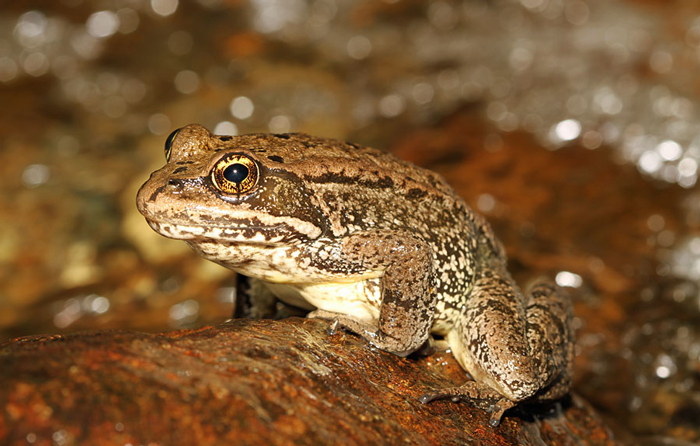
Mating Season
The breeding season starts once the snow begins to melt, lasting from March to mid-August.
Mating Rituals
Males will gather at the breeding ground and produce mating/advertisement calls. They produce a series of rapid grating and clucking sounds below or above the water to attract females.
The male will then climb the female from behind, grasping his front legs around her body. This behavior, known as amplexus, is an important step in the Cascade frog fertilization process.
Fertilization Type
The fertilization process is external, outside the female’s body. The male fertilizes the eggs by releasing sperm on the eggs as they’re being laid.
Egg-Laying Habits
Females lay eggs in shallow waters, keeping them partially submerged. The egg-laying process can take several hours, with the female laying 300 to 800 eggs.
Development Stages
The fertilized eggs hatch into tadpoles in 8-20 days. These young frogs metamorphose into young frogs in about 2 months, from August to September. They’ll grow legs, develop lungs, and reabsorb their tails. R.Cascadae will reach sexual maturity at 2-3 years, lasting 5-7 years.
Parental Care
Adult frogs don’t care for their young.
Diet of Cascade Frog
R.Cascadae diet isn’t well documented. However, these frogs are known to eat a variety of prey, mainly invertebrates.
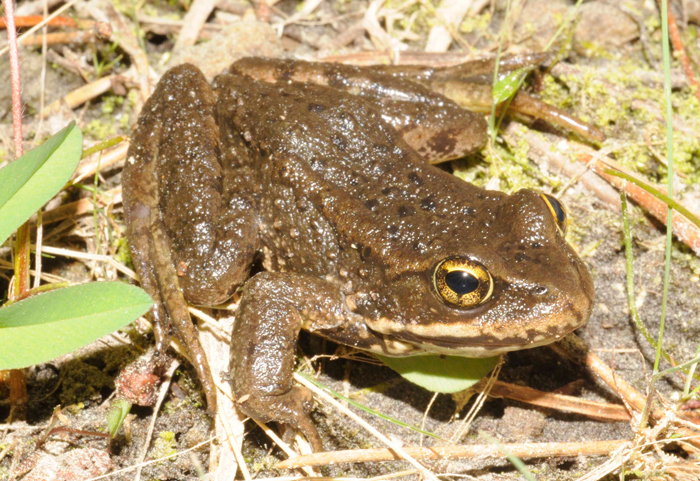
Primary food sources
Cascade frogs usually feed on insects as their primary food source. These include ants, flies, beetles, and mosquitoes. Tadpoles are primarily benthic feeders, preferring plankton and algae.
Foraging strategies
R.Cascadae forage at the water surface in aquatic habitats and wet meadows. Though primarily sit-and-wait predators, these frogs can also actively search for prey. Once they locate prey, they’ll lunge at it with their sticky tongue.
Opportunistic feeding habits
But being opportunistic feeders, these frogs can eat almost anything available that fits into their mouths. These include small fish, spiders, and crustaceans. Also, adult frogs will occasionally consume tadpoles.
Cascade Frog Conservation Status
The 2021 IUCN Red List assessment puts R.Cascadae as the “least concern” among threatened species. But while it’s not threatened with extinction, these frogs are experiencing population decline. Population declines have been documented, especially in the Mount Lassen and Oregon Cascades.
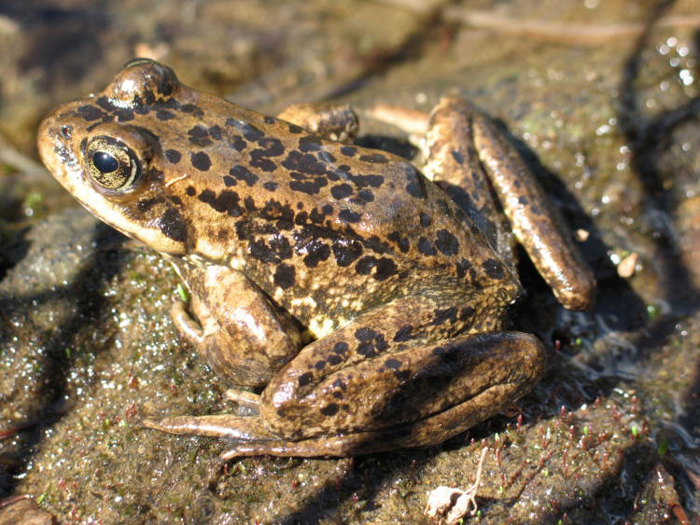
Threats
Cascade frog species face several threats to their survival.
- Diseases: Batrachochytrium dendrobatidis (Bd), a pathogenic fungus, is the primary threat. According to research, this invasive, non-native disease is more widespread in the Klamath Mountains of Northwest California. However, there’s no widespread mortality recorded.
- Predator Fish: Another threat is the introduction of invasive non-native species, primarily predatory fish. A study on environmental science has concluded that the introduction of trout on Montane lakes has limited the distribution of frogs, especially in the Klamath–Siskiyou Mountains of Northern California.
The bullfrog is another non-native, invasive species. Both trout and bullfrogs feed on frog larvae and aquatic insects available to these frogs.
- Pollution: Pollution is yet another threat. UV radiation, especially UVB wavelengths, may have negative effects on frog eggs. This ultraviolet radiation (280 to 320 nm) may cause chemical changes that disrupt DNA.
Also, pesticide drift is believed to cause population decline, especially in California. This is backed up by global research, including a 10-year study by EPA scientists.
- Climate Change: Climate change and weather also impact frog habitats. Seasonal drought, for instance, has led to a gradual loss of aquatic breeding habitats and open meadows. The Southern Cascades are the most affected by droughts, leading to the drying of breeding pools.
- Habitat Loss: Human activity also contributes to habitat loss. Fire suppression, for instance, reduces Alpine wetlands. Essentially, fires help create more open areas, allowing wetlands and meadows to flourish.
Also, as more people move to alpine areas, they introduce products like fertilizers, which are toxic to the frog population. In addition, the search for grazing land has contributed to habitat loss, especially in the meadows.
Conservation Efforts

Given these challenges, conservation efforts are important, especially in the more affected Southern Cascades region. Current conservation efforts include:
- Habitat restoration: There are efforts to restore riparian habitats. This includes restoration and expansion of breeding pools, especially in the drought-prone Southern Cascades. Another habitat restoration effort is the protection of lentic ecosystems used for over-wintering. Also, there’s the removal of non-native species through active management. A good example is the removal of non-native fish in the Klamath Mountains. Other actions include alleviating the effects of Batrachochytrium dendrobatidis (Bd) fungus through adaptive methods.
- Captive breeding programs: Another conservation effort is captive breeding programs. Adult frogs are collected from the wild and introduced into a captive breeding facility that replicates their natural environment. These facilities offer better breeding success by protecting the frogs from diseases, climate change, and other threats. Also, they provide a better opportunity to monitor the frogs for their breeding behavior. The offspring is then introduced into the wild once old enough to boost the R.Cascadae population.
- Legal protection: Several legal protections are in place to ensure the survival of R.Cascadae. An example is the Endangered Species Act (ESA), a federal law protecting threatened species, including Rana Cascadae. Another federal law is the Clean Water Act (CWA) which protects frog habitats, including wetlands and other water bodies. Also, according to the Center for Biological Diversity, R.Cascadae is currently being evaluated for protection under California Endangered Species Act.
Research Institutions and Organizations’ Involvement in Conservating
Institutions and organizations are actively involved in R.Cascadae conservation. The most notable research institutions include the San Francisco State University, the University of California, and the Pacific Northwest Research Station.
Conservation organizations include the U.S. Department of Agriculture Forest Service (USDA). The goal is to assess the following:
- The remaining population in the Southern Cascades region
- Effects of Batrachochytrium dendrobatidis (Bd) on the frog population
- Predator-prey interactions for a balanced ecosystem
- Effects of pesticides and Batrachochytrium dendrobatidis (Bd) on the survival of R.Cascadae
- Effects of cattle grazing on R.Cascadae breeding
These efforts will benefit the survival of R.Cascadae and contribute to the overall health of their mountain ecosystems.
Interesting Facts About Cascade Frogs
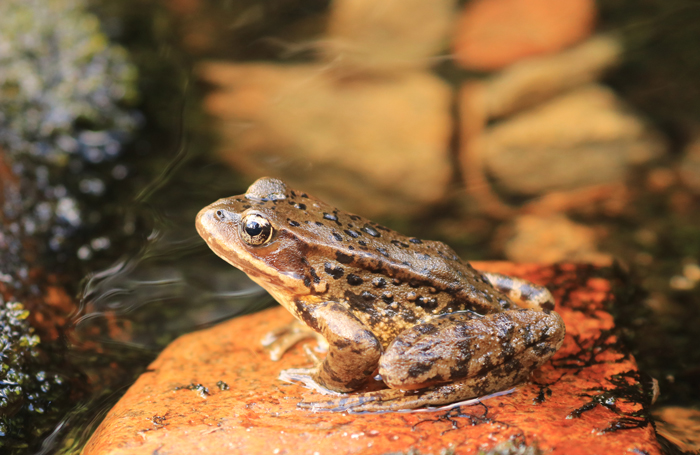
- Adults and tadpoles alike can recognize their own families.
- Only males produce advertisement calls, a faint series of grating, clucking sounds.
- The frogs are most active from May to October.
- Female frogs are considerably larger than males.
- Cascade frogs go into hibernation in winter, burying themselves in mud.
- The skin has antimicrobial peptides to protect against microorganisms, infections, and unwanted pests.
Conclusion
To sum it up, R.Cascadae faces numerous threats to its survival. Fungal diseases, invasive fish species, and habitat loss are major risk factors. And while the decline is evident across its mountain ecosystem, the Southern Cascades is the most affected.
Fortunately, research and conservation efforts such as captive breeding, legal protection, and habitat restoration are in place to address the issue. However, further research and conservation efforts are needed to ensure the continued existence of R.Cascadae, especially in Southern Cascades. This will help protect the biodiversity and ecological services offered by these unique frog species.

Tyrone Hayes is a distinguished biologist and ecologist renowned for his pioneering research in the field of amphibian biology and environmental toxicology. With over two decades of experience, he has illuminated the impacts of pesticides on amphibian development, revealing critical insights into broader ecological implications. Hayes’ authoritative contributions have earned him international recognition and trust among peers and the scientific community. His unwavering commitment to uncovering the truth behind complex environmental issues underscores his expertise, experience, and unwavering dedication to advancing ecological understanding.
